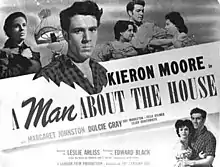A Man About the House
A Man About the House is a British drama film directed by Leslie Arliss and released in 1947. The film is a melodrama, adapted for the screen by J. B. Williams from the 1942 novel of the same name by Francis Brett Young.[3] A theatrical adaptation A Man About the House by John Perry had been staged in London's West End in 1946, with Flora Robson as Agnes, Kieron Moore as Salvatore, and Ernest Thesiger as Sanctuary.[4] The film was produced by Edward Black and edited by Russell Lloyd, with cinematography by Georges Périnal and music by Nicholas Brodszky. Shot at Shepperton Studios and on location around Naples, the film's sets were designed by the art director Andrej Andrejew.
| A Man About the House | |
|---|---|
 UK release poster | |
| Directed by | Leslie Arliss |
| Written by | J.B. Williams Leslie Arliss |
| Based on | A Man About the House by Francis Brett Young |
| Produced by | Edward Black |
| Starring | Dulcie Gray Margaret Johnston Kieron Moore Guy Middleton |
| Cinematography | Georges Périnal |
| Edited by | Russell Lloyd |
| Music by | Nicholas Brodszky |
| Color process | Black and white |
Production company | |
| Distributed by | British Lion Films |
Release date |
|
Running time | 94 minutes |
| Country | United Kingdom |
| Language | English |
| Budget | £304,521[1] |
| Box office | £187,115 (UK)[2] |
Plot
Two impecunious English sisters, Ellen and Agnes Isit (Dulcie Gray and Margaret Johnston), unexpectedly inherit a Neapolitan villa from a deceased uncle and move to Italy to view and sell their property. A local man, Salvatore (Kieron Moore), has, since a boy, been employed by the deceased uncle becoming major domo and he now manages the villa and its vineyard. Exploring her late uncle's studio, Ellen uncovers a painting of a nude Salvatore as Bacchus.
Soon Ellen becomes drawn to the carefree life of the locals and the romantic charisma of Salvatore, while the prudish Agnes resists. During the raucous revelry of the grape-treading festival, Agnes succumbs to her suppressed desire. Rushing to the balcony she cries out for Salvatore who drops a local woman he's kissing and climbs from the grape vat and to her bedroom. The pair are quickly married and husband Salvatore now is master of the estate.
Soon, Ellen becomes aware of a change in Salvatore's behaviour towards Agnes. Not long after the marriage, Agnes's health begins to deteriorate and Ellen's suspicions are aroused. She expresses her concerns to a visiting English doctor, Benjamin Dench (Guy Middleton) who is Agnes's former fiance. Ellen is convinced that Agnes is being poisoned. She enlists Dench's help in trying to prove that Salvatore is slowly murdering her sister with arsenic. The villa once belonged to Salvatore's family and he has long been determined to regain ownership. Having poisoned his employer to inherit, he had not anticipated the sisters' arrival on the scene.
The film culminates in a clifftop struggle between Salvatore and Dench, who beats Salvatore and tells him to flee to America at once or face the consequences. Ellen and Dench return to the villa to tend the sickened and weak Agnes. Suddenly they learn that Salvatore is dead. His body is brought from the bay by villagers, having cast himself from the clifftop in despair rather than lose his family's former property. Ellen and Dench, who have fallen in love, depart together to England and leave the recovered Agnes, who is determined to remain at the villa and to fulfil her dead husband's wishes, tending the vineyard.
Cast
- Dulcie Gray as Ellen Isit
- Margaret Johnston as Agnes Isit
- Kieron Moore as Salvatore
- Guy Middleton as Dr. Benjamin Dench
- Felix Aylmer as Richard Sanctuary
- Lilian Braithwaite as Mrs. Armitage
- Reginald Purdell as Higgs
- Wilfred Caithness as Solicitor
- Gina Lollobrigida as a young girl
- Jone Salinas as Maria
- Marisa Finiani as Assunter
- Fulvia De Priamo as Gita
- Nicola Esposita as Antonina
- Andreas Malandrinos as Peasant
- Philip Ridgeway as Polite Man
- Victor Rietta as Railway Porter
Reception
As of 30 June 1949 the film earned £166,075 in the UK of which £111,820 went to the producer.[1]
References
- Chapman, J. (2022). The Money Behind the Screen: A History of British Film Finance, 1945-1985. Edinburgh University Press p 354
- Vincent Porter, 'The Robert Clark Account', Historical Journal of Film, Radio and Television, Vol 20 No 4, 2000
- "A Man about the House (1947)". BFI. Archived from the original on 7 May 2019.
- Wearing, J. P. (22 August 2014). The London Stage 1940-1949: A Calendar of Productions, Performers, and Personnel. Rowman & Littlefield. ISBN 9780810893061 – via Google Books.
- TimeOut Film Guide - published by Penguin Books - ISBN 0-14-029395-7
External links
- A Man About the House at IMDb
- A Man About the House at AllMovie
- Review of film at Variety